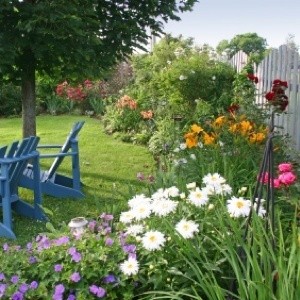With all of their colors, shapes, and textures, it's hard to imagine designing a garden without perennials. One of the greatest advantages of using them in the garden is their longevity.
Well placed perennials will reward you with seasons of beautiful color for years to come. Here are some helpful suggestions for planning perennial beds and borders to help you get the most of these versatile plants.

Make a list.
Start the design process by making a list of perennials that have proven successful in your area. Check the gardening section of your library, search online, or ask your county extension agency for recommendations. Once you have your list, try to narrow it down to your top 10 to 12 favorites.
Plan for all seasons.
By planting perennials that bloom at different times, you can avoid the dreaded color gap. Adding a few annuals, summer bulbs, and low-growing shrubs into the mix will provide continuous color and interest across the seasons.
Go native.
Plants always grow best in conditions similar to their natural habitat so consider planting some native plants. It's always easier to match a plant to your garden conditions, than to try to change your garden conditions to match a plant.
Simplify the color scheme.
If want to create a sense of harmony, select a color scheme consisting of 2 or 3 colors that compliment each other (for example, blues, purples, and pinks; or yellows, oranges, and reds). Use the color of your house as the backdrop. An inexpensive color wheel (available at art supply stores) can help you identify colors that will compliment your house.
Plant drifts of color.
Plants generally look better when massed together in different sized groups, rather than individual plants scattered here and there.
Vary the heights.
The old rule of putting tall plants in the back and short ones in front doesn't necessary always apply. If a flower bed can be viewed from both sides, the tallest plants should be planted toward the middle.
Step 1: Select a size and shape.
Most perennials tend to fall on the side of 'informal' so irregular-shaped beds and gently curving borders are preferable to the more formal circles, ovals, and perfectly straight lines. When creating the size of the beds, the amount of space you have and your ability to maintain it are the most important factors. Borders look best when they are at least twice as long as they are wide. A island bed no more than 4 feet wide will give you easy access from both sides.
Step 2: Prepare the soil.
Soil is the most important ingredient in a successful garden. Begin by turning over the soil with a spade and clearing the area of weeds. Add in plenty of compost and well-rotted manure to improve the soil's structure and get plants off to a good start. An ideal pH level for most perennials falls somewhere between 6.0 and 7.5. If you're unsure of yours, have it tested.
Step 3: Give plants space.
When constructing beds near fences or foundation walls, try to leave at least 12 to 14 inches of space between the plants and nearby structures. Not only will this provide ample air circulation and help mitigate the potential for disease, but it will make weeding, watering, and other chores much easier on you.
'Plant' on paper first.
No matter how bad you think you draw, it's always worthwhile to sketch out a diagram of your design on paper before planting a new bed. Use colored pencils (corresponding to the colors to each plant) and draw circles indicating location and the plant's mature width. Start with the tallest (anchor) plants first, placing them at the back or in the center of the your bed. As you continue to draw, think about various color and texture combinations and when each plant is in flower.
Pot up invasive perennials.
Some perennials, such as members of the mint family, can be highly invasive if left unchecked. To prevent them from taking over, plant them in terra cotta pots and sink the entire plant (pot and all) into the ground. When the plants become overcrowded, simply dig up the container, divide the plants, and repot them.
Add in some annuals.
Most perennials take 3 or more years to really fill out and reach their potential. Annuals are a wonderful way to add season-long color and fill in the gaps in the meantime.
Plant when the time is right.
So when is the best time to plant? In the North, plant your perennial beds and borders in the spring so that plants have plenty of time to settle in and establish themselves before winter. Warmer zones can take advantage of the warm soil and reliable rains of fall, allowing at least two months before the cold sets in for the plants to develop root reserves.
I agree with simplifying the color scheme...it makes the whole patio and yard look unified. I try to stick to 2-3 colors and mix in textures to add some difference.